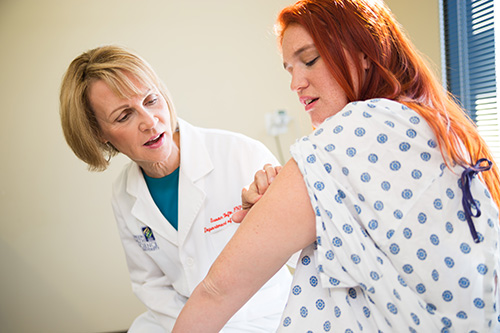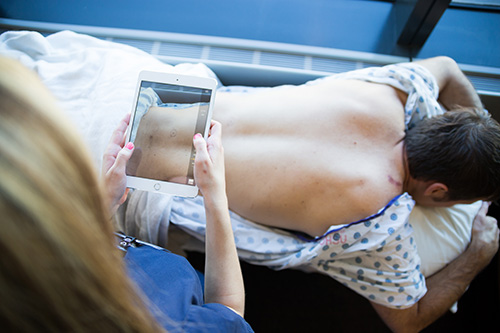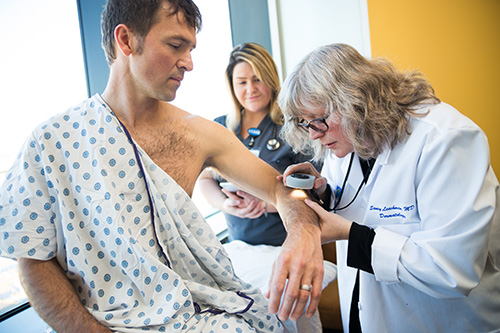How Melanoma is Diagnosed
What to expect in an exam from a health care professional
A medical exam will include health history questions about you and your family. Your provider may also perform a physical exam, where they carefully inspect your skin for abnormal spots, also called lesions.
If your provider is concerned that a lesion may be skin cancer, a sample must be removed to test for cancer cells under a biopsy. Often, the entire lesion is removed to check for cancer cells.
What to expect with a biopsy
Before a biopsy, your skin will be numbed with local anesthetic (a medicine that results in loss of feeling for a short time, to prevent pain from a medical procedure.) Tell your provider if you have had any reaction to anesthesia in the past. After the biopsy, the provider might close the wound with sutures (or “stitches”). Depending on the type of biopsy, sutures might not be necessary.
Your provider will send the tissue sample to a pathologist, a doctor who specializes in the examination of tissue through a microscope, to determine if it is cancer or not. Your provider will contact you to tell you what the results are. If you do not receive results within 2 weeks, contact to your provider.
If the result is positive
If the pathologist finds cancer cells in the sample from the biopsy, more tests may be needed. They will assess if cancer cells are growing into the deeper layers of the skin, and how deeply they are growing. This will determine if more tests, or treatment such as the removal of more skin around the original lesion, are necessary.
If the result is negative
Your provider may tell you that the results were negative (benign). In this case further treatment is usually not recommended. Be sure to do regular self-exams to check for changing moles.
Medical Exams

A medical exam will include health history questions about you and your family, since certain factors may increase your risk of melanoma. Your provider may also perform a physical exam, where they carefully inspect your skin for abnormal spots, also called lesions. They may take photographs to document specific lesions in your medical record.
Suspicious Spots

If your provider is concerned that a lesion may be skin cancer, a sample must be removed to test for cancer cells under a biopsy. Often, the entire lesion is removed to check for cancer cells.
Biopsy

Before a biopsy, your skin will be numbed with local anesthetic. A local anesthetic is a medicine that results in loss of feeling for a short time, to prevent pain from a medical procedure. Tell your provider if you have had any reaction to anesthesia in the past. After the biopsy, the provider might close the wound with sutures (or “stitches”). Depending on the type of biopsy that might not be necessary.
Pathology

Your provider will send the tissue sample to a pathologist, a doctor who specializes in the examination of tissue through a microscope to determine if it is cancer or not. Your provider will contact you to tell you what the results are. This may take several days or weeks, but this is common.
Results

If the pathologist finds cancer cells in the sample from the biopsy, more tests may be needed. They will assess if cancer cells are growing into the deeper layers of the skin, and how deeply they are growing. This will determine if more tests, or treatment such as the removal of more skin around the original lesion, are necessary.
Sometimes, the result is not clear, and a pathologist might see some features that suggest cancer, and others that suggest it is not cancer. Your provider may suggest additional tests, a second opinion, or additional surgery if the result is not clear. Talk about all your options with your provider, and visit AIMatMelanoma.org to talk to a physician assistant for confidential answers to questions about melanoma.
Watch for Changes

Your provider may tell you that the results were negative, or they may tell you that a biopsy is negative, but they will often encourage you to check for changes in any lesion that was evaluated or other spots on your skin. Be sure to do regular self-exams and be aware of any changes.

You should check your skin on a regular basis to recognize abnormal spots. Use a mirror for areas that are hard to see, or have a partner help you. Inspect all areas of your body. Remember, a changing spot is an important warning sign. Talk to your healthcare provider about anything that is concerning to you.
Mole mapping by keeping track on paper, or by using an iPhone app like MoleMapper can help you track your moles for changes, remind you to do regular exams, and show photos over time to your provider. It is not able to diagnose melanoma, but it can be useful to stay aware of your skin and be alert for changes. You can learn more at www.molemapper.org.
Learn More
You can read more about melanoma tests and treatments in the Melanoma Guidelines from the National Comprehensive Cancer Network online at www.nccn.org/patients/guidelines/melanoma.


